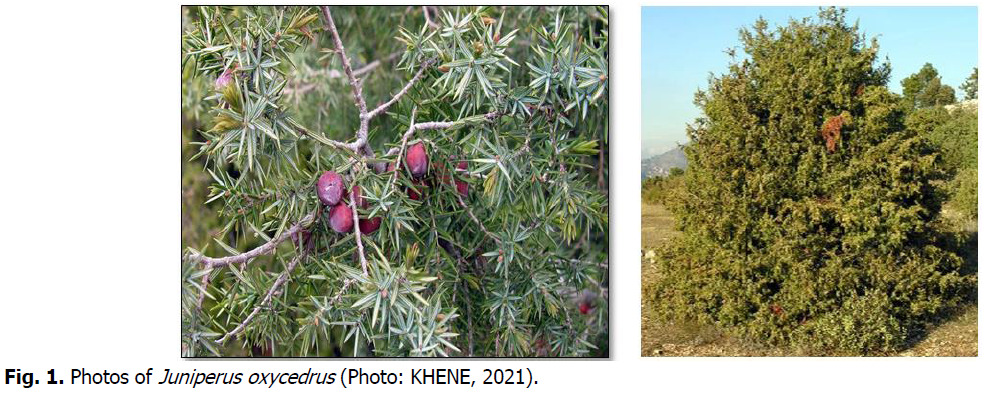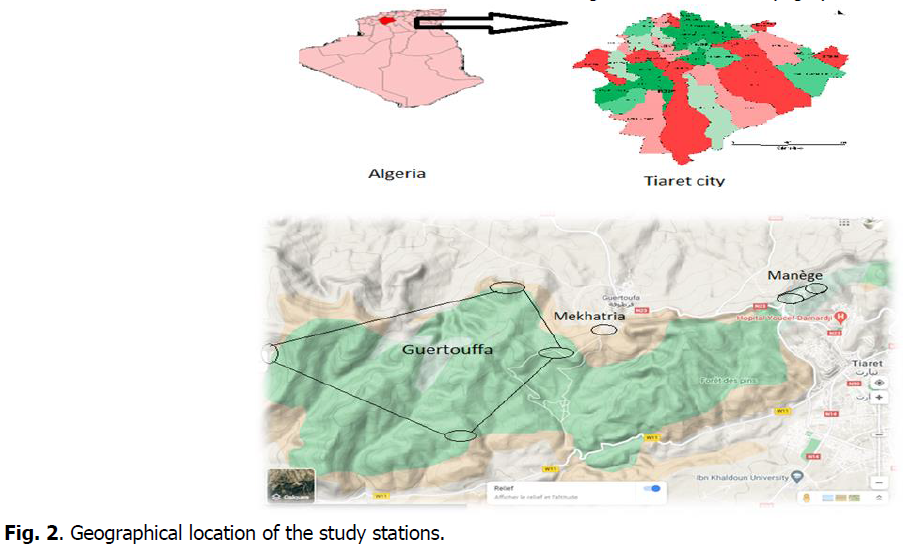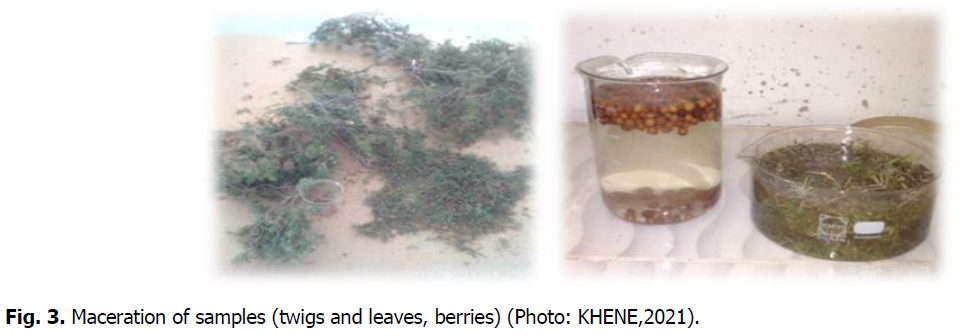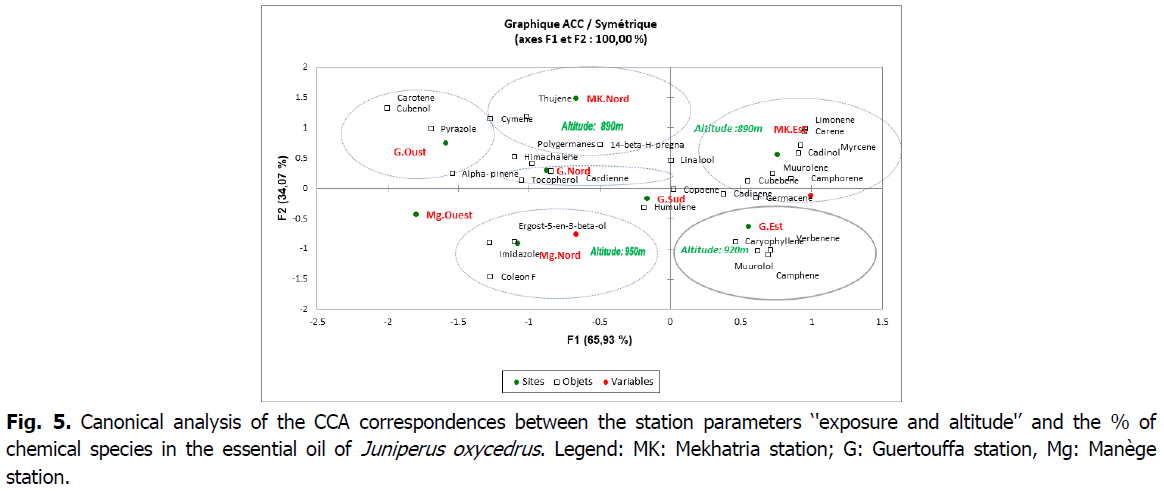Research Article - (2021) Volume 0, Issue 0
Extraction, yield and chemical composition of essential oils of Juniperus oxycedrus L. from Tiaret region (Algeria)
S. Guerroudj1*, M. Maatoug2, K. Naceur2, R. Chaibi1, M. Khene2 and A. Boualem2Abstract
Three forest stations in the Tiaret forest were chosen as sampling sites for Juniperus oxycedrus L: Guertouffa, Mekhatria and Manège, depending on exposure and altitude, in order to study the yield and chemical composition of the essential oils of this shrub. The results found for yield showed a percentage of the order of 0.23 to 0.32% in the leaves; on the other hand, it can go up to 0.80% in the berries. The GC/MS chromatographic analysis of G. oxycèdre essential oils allowed the definition of 49 chemical species, divided into 32 families, of which the Carenes (2-Carene, delta-3-Carene), and the Mycenes (beta.-Myrcene), presented high percentages, i.e., 24.72% and 13.84 respectively. A distribution of the chemical species found, according to the exposure and the altitude of the sampled stations, is remarkable, and has made it possible to note the effect of the station factors on the quantity and nature of these oils.
Keywords
Essential oils, Yield, Carenes, Myrcenes, GC-MS chromatograph, Tiaret.
Introduction
Algeria is one of the countries that presents a great diversity of biotope occupied by an important floristic wealth, constitutes in some cases ecosystems of world interest. However, the severe, irregular and sudden climatic constraints, with in particular the phases of prolonged drought influence negatively the growth of trees and the natural regeneration.
The J. oxycedrus is a very common species in degraded forests of semi-arid regions in Algeria (Fig. 1). According to Boudy (1950), Maire (1952) and Quezel & Santa (1962), it covers an area of 112 000 ha, from the coastal dunes to the limits of the great Sahara, much more often as a smaller bushy shrub. Moreover, this taxon has a considerable ecological role because it is resistant to drought (Riou-Nivert, 2001) and therefore to soil degradation and anthropic pressure, especially in the most arid regions.

Fig 1: Photos of Juniperus oxycedrus (Photo: KHENE, 2021).
This species can appear either in for-mations in which dominates the tree and shrub layer, or in mixed masses with individ-uals of Quercusfaginea subsp. Faginea. Lam., Quercus ilex. subsp. ballota (Desf) Samp., Quercuspyrenaica, Pinusnigra Arnold. subsp. salzmannii, Pinus pinaster.Ait. andPinus sylvestris.L
In Algeria, various studies have been conducted on essential oils oxycèdre (Bensegueni-Tounsi, 2001), chemotaxonomy (Dob et al., 2008), the antibacterial and antifungal effect of some vegetative organs (Foudil-Cherif &Yassaa, 2012), mono-terpenes and anti-oxidant properties of needles and galls (Fadel et al., 2016).
This work aims to identify mainly the chemical composition of essential oils that can be derived from this species (Juniperus oxycedrus L.) in the region of Tiaret, in order to study the effect of altitude and exposure on the variability of different chemical species found by GC-MS.
Presentation of the study area
The study area is located in the pine forest of the Wilaya of Tiaret (154200Ha) in the North-West of Algeria between the Tellian chain in the North and the Atlassian chain in the South, at an average altitude of 980 m (Fig.2).

Fig 2: Geographical location of the study stations.
In the whole of the Tiaret forest, three stations were randomly selected, each measuring 200 m x 100 m. These were:
• Guertouffa station, at an altitude of 950 m and with four exposures: North, South, East and West,
• Manège station, at an altitude of 920 m and two exposures North and West,
• Mekhatria station, at an altitude of 890 m and two exposures North and East.
The plant formation is composed of Pinus helepensis Mill. in the tree layer and Juniperus oxycedrus L. in the shrub layer. The herbaceous stratum is composed of Stippa tenacissima L.and Ampelodesmos mauritanicus (Poir.) indicating the aridity of the environment. The climate is semi-arid Mediterranean with an average annual rainfall of 400 mm/year. The predominant winds come from the west and northwest, with average speeds of 3 to 4 m/s.
The samples were taken in such a way as to limit contamination, neither loss nor pollution, by avoiding the use of tools or containers likely to decontaminate the sample (steel or stainless steel tools, containers with walls containing pigments based on trace elements, such as PVC). The geographical coordinates (x, y) of each sample were recorded using a GPS. The samples of the species are collected, registered and transported in paper bags on the day of collection.
Methodology
The hydrodistillation method is used to extract essential oils from J. oxycedrus, using a Clevenger. In addition, the starting sample contained 200 g of crushed Juniperus oxycedrus leaves with 600 1.5 L of distilled water for 24 hours (Fig.3.). The samples underwent hydro-distillation, at least 02h 45mn. The recovered essential oil was stored at +4°C until use.

Fig 3: Maceration of samples (twigs and leaves, berries) (Photo: KHENE,2021).
Results and Discussion
Essential oil yields of Juniperus oxycedrus
The yields of essential oils obtained by hydro-distillation are presented in Table 1.
| Exposition | Type of sample | N | PA (gr) | PB (gr) | (yields %) | Moy ± SD% |
|---|---|---|---|---|---|---|
| Guertouffa West | berries | 3 | 200 | 2.10 | 1.05 | 0.82 ± 0.20% |
| 200 | 1.47 | 0.74 | ||||
| 200 | 1.34 | 0.67 | ||||
| Guertouffa North | Twigs and leaves | 3 | 200 | 0.30 | 0.15 | 0.23 ± 0.068% |
| 200 | 0.49 | 0.25 | ||||
| 200 | 0.56 | 0.28 | ||||
| Guertouffa South | berries | 3 | 200 | 1.20 | 0.60 | 0.60 ± 0.045% |
| 200 | 1.10 | 0.55 | ||||
| 200 | 1.28 | 0.64 | ||||
| Guertouffa East | Twigs and leaves | 3 | 200 | 0.61 | 0.31 | 0.32 ± 0.026% |
| 200 | 0.70 | 0.35 | ||||
| 200 | 0.59 | 0.30 | ||||
| Manège West | berries | 3 | 200 | 1.37 | 0.69 | 0.66 ± 0.089% |
| 200 | 1.12 | 0.56 | ||||
| 200 | 1.46 | 0.73 | ||||
| Manège North | Twigs and leaves | 3 | 200 | 0.33 | 0.17 | 0.20 ± 0.03% |
| 200 | 0.46 | 0.23 | ||||
| 200 | 0.39 | 0.20 | ||||
| Mekhatria North | Twigs and leaves | 3 | 200 | 0.64 | 0.32 | 0.26 ± 0.057% |
| 200 | 0.48 | 0.24 | ||||
| 200 | 0.41 | 0.21 | ||||
| Mekhatria East | berries | 3 | 200 | 1.30 | 0.65 | 0.66 ± 0.05% |
| 200 | 1.22 | 0.61 | ||||
| 200 | 1.42 | 0.71 |
Table 1. (%) of the yields of essential oils of Juniperus oxycedrus.
We find that the yields from hydro-distillation of berries are twice those obtained with leaves and twigs of J. oxycedrus for the three sites, with an average ranging from 0.26 ± 0.057% to 0.82 ± 0.20%. Several authors cited that the yield of essential oil varied from 0.1% to 0.2% (Dob et al., 2006; Mansouri et al., 2010) in Juniperus oxycedrus harvested in the region of Amassine-Ourika, at an altitude of 1300 m, in Marrakech (Morocco), reached 0.15% and the yield of berries reached 0.72% (Achak, 2006).
The yield of essential oils from Juniperus oxycedrus berries is around 2.12%, according to Alan et al. However, Dob, et al., (2006) point out that the yield of Juniperus oxycedrus berries growing spontaneously in Djelfa, Algeria, is around 0.10% on average, while the yield of berry samples collected in Corsica is also low, varying between 0.10 and 0.22% (Ottavioli 2009). Furthermore, J. oxycedrus berries collected in Sardinia and Greece provided yields in the order of 0.49% and 0.40%, respectively (Angioni, et al., 2003, Stassi, et al., 1995). These values are very close to those of the samples taken from Guertoufa South (0.60%). In J. oxycedrus leaves, a slightly lower yield than our results of 0.3% was obtained by several authors (Alberto, et al., 2003, Ghanmi, et al., 2010), Boti, et al., (2006) found 0.04-0.26% in the leaves of J. oxycedrus from Corsica (Amri, et al.,2011), Guendouzen and Haddouche, (2006) confirm comparable rates varying between 0.20 and 0.42%" in the leaves and 0.28-1.53% in the cones of J. oxycedrus from Tunisia. Ces variations de rendement en huiles essentielles peuvent être attribuées à la variabilité génétique de l'espèce, mais aussi à la localisation géographique spécifique de chaque espèce (Boufares, et al., 2019).
4-Chemical composition of the essential oils of Juniperus oxycedrus
The oils obtained by extraction were passed through a Shimadzu GC-MS, which subsequently gave a base file. The chromatographic peaks were processed by Labsolutions software (ver 4.50), using the database from two libraries: Wiley7n.L and NIST11.L. This software allows in particular to give the chemical name of each compound, the% of its area and its rention times.
The Fig. 4 represents a chromatogram of the sample taken in Guertouffa Ouest analysed by GC/MS. The chemical species found are classified by families (https://fr.wikipedia.org/) and the calculation of the percentage of each chemical species in each essential oil sample was done according to the global Aera and Aera taking into account the retention time.

Fig 4: GC/MS chromatograms of a sample taken in Guertouffa West.
From all the GC/MS chromatograms, 49 chemical species were defined, divided into 32 families. The percentages of the areas found are shown in Table 2.
| Familly | Chimicals Species | Nbr Species | Area | % Area | RT moy(min) |
|---|---|---|---|---|---|
| Pyrazole | 1,2,5-Oxadiazole, 2,2',5,5'-Tetrabromo-4,4'-bithiazole,5-[2'-Hydroxy-4'-chlorophenyl]-3-(2",4"-dichlorophenyl)-1-decylpyrazole, 5-[2'-Hydroxy-4'-chlorophenyl]-3-(2",4"-dichlorophenyl)-1-decylpyrazole, 1H-Carbazole, 2,3,4,9-tetrahydro-7-nitro-, 4-(4-Methylphenyl)-4H-1,2,4-triazole,3-Methyl-1,5-diphenyl-2-pyrazoline | 7 | 1482604 | 0,083 | 12,69±3,56 |
| Thujene | 3-Thujene,4(10)-Thujene,4(10)-Thujene | 3 | 10268847 | 0,572 | 7,33±0,38 |
| Alpha-pinene | 2-Pinene, 2(10)-Pinene,2(10)-Pinene, 2(10)-Pinene, 2(10)-Pinene. | 5 | 73089006 | 4,070 | 7,25±0,34 |
| Cymene | o-Cymene, o-Cymene, o-Cymene. | 3 | 9102687 | 0,507 | 8,18±0,02 |
| Imidazole | 1H-Imidazole, 4-nitro-2-Hydroxybenzimidazole, 2TBDMS derivative, 2-Hydroxybenzimidazole, 2TBDMS derivative, 1H-Imidazo[4,5-h]quinoline, 5-hydrazino-2-methyl. | 4 | 5772105 | 0,321 | 16,72±3,82 |
| Copaene | Copaene, Copaene, Copaene, Copaene, Copaene, Copaene, (1) alpha.-Copaene | 7 | 29577538 | 1,647 | 12,98±1,00 |
| Caryophyllene | Caryophyllene, Caryophyllene, Caryophyllene oxide | 3 | 3131406 | 0,174 | 14,43±2,08 |
| Cubebene | alpha.-Cubebene, alpha.-Cubebene, alpha.-Cubebene, Cubenene, Cubenene |
5 | 68737336 | 3,828 | 13,78±1,39 |
| Humulene | alpha.-Humulene, alpha.-Humulene, alpha.-Humulene, alpha.-Humulene, alpha.-Humulene Humulene epoxide I, Humulene epoxide I |
7 | 9320529 | 0,519 | 13,97±0,68 |
| Muurolene | gamma-Muurolene, alpha.-Muurolene, beta Muurolene |
3 | 51560210 | 2,871 | 13,95±0,17 |
| Germacene | (-)-Germacrene D, (-)-Germacrene D, (-)-Germacrene D, (-)-Germacrene D, (-)-Germacrene D |
5 | 492237351 | 27,413 | 13,88±0,08 |
| Cardienne | delta-Cadinene, delta-Cadinene, delta-Cadinene, delta-Cadinene, delta-Cadinene, delta-Cadinene, gamma-Cadinene, beta-Cadinene |
8 | 108290402 | 6,031 | 14,12±0,20 |
| Cubenol | Cubenol | 1 | 56963 | 0,003 | 14,40 |
| Muurolol | tau.-Muurolol, tau.-Muurolol | 2 | 1988910 | 0,111 | 15,38±0.08 |
| Carotene | beta. Carotene | 1 | 6550 | 0,004 | 21,78 |
| Polygermanes | Hexagermane, Hexagermane | 2 | 61715 | 0,003 | 14,34±2.66 |
| 14-beta-H-pregna | 14-.beta.-H-pregna, | 4 | 1185605 | 0,066 | 19,51±1,81 |
| Himachalene | gamma.-HIMACHALENE | 1 | 984460 | 0,055 | 15,45 |
| Coleon F | dimer of Coleon F | 2 | 36136 | 0,002 | 18,00±0,16 |
| Ergost-5-en-3-beta-ol | Ergost-5-en-3-beta-ol, Ergost-7-ene-3,6,23-triol, triacetate, (3.beta.,5.alpha.,6.alpha.,23R)- | 3 | 2161101 | 0,120 | 18,67±6,79 |
| Camphene | (2) Camphene | 2 | 21376551 | 1,190 | 7,25±0,07 |
| Verbenene | Verbenene | 1 | 19056 | 0,001 | 7,24 |
| Myrcene | beta.-Myrcene, beta.-Myrcene | 2 | 248667565 | 13,847 | 7,82±0,10 |
| Carene | 2-Carene, delta-3-Carene | 2 | 44013348 | 24,727 | 8,16±1,34 |
| Linalool | Linalool, Linalool | 2 | 11442888 | 0,637 | 9,17±0,03 |
| Cadinol | tau.-Cadino, tau.-Cadino | 2 | 106946694 | 5,956 | 15,35±0,05 |
| Camphorene | m-Camphorene, m-Camphorene | 2 | 7455437 | 0,415 | 18,08±0,01 |
| Tocopherol | alpha.-Tocopherol-.beta.-D-mannoside, dl-.alpha.-Tocopher | 3 | 5880884 | 0,328 | 20,55±0,01 |
| Limonene | D-Limonene | 1 | 75710023 | 4,216 | 8,37 |
Table 2. Percentage of areas of different essential oil compounds.
The analysis of Table 2 shows that:
The Pinene, Cubebene, Muurolene, Cadinene families recorded an area varying from 1.64 to 6.03% (all exposures combined). However, the largest percentage is recorded for the Carene family (2-Carene, delta-3-Carene), i.e., 24.7% and Myrcene (beta.-Myrcene), i.e., 13.84%. Indeed, Carenes are a group of terpenes, These oxygenated terpenes constitute essentially a minority of the oil, which is mainly composed of limonene and other terpene hydrocarbons, these include terpene hydrocarbons (monoterpenes, sesquiterpenes), alcohols, esters, aldehydes, ketones and volatile organic acids (Bousbia, 2013). Beta-myrcene, also as a monoterpene, is present as a yellowish liquid with a strong aromatic smell. Furthermore, rosemary harvested in Portugal (Serrano, et al., 2002) is rich in myrcene (25%).
Relation: geographical parameters-chemical composition of essential oils
In order to study the effect of exposure and altitude on the distribution of the nature and chemical compounds of the essential oils in the Juniperus oxycedrus tree, we carried out a canonical correspondence analysis (CCA), taking into account these parameters for the three sampling stations: Guartoufa, Manège and Mekhatria. The result of this CCA is shown in Fig. 5.

Fig 5: Canonical analysis of the CCA correspondences between the station parameters ‘'exposure and altitude'’ and the % of chemical species in the essential oil of Juniperus oxycedrus. Legend: MK: Mekhatria station; G: Guertouffa station, Mg: Manège station.
Two dimensions can be interpreted
• F1 which represents 66% of scatterplots (66% of information can be explained in this dimension).
• F2 which represents 34% of scatterplots can be explained in this axis.
On the F1 on the positive side, we find: Alt 890 m, Mekhatria East which corresponds with the species: Limonene, Myrcene, Alpha-Carene, Camphene, Cymene, Linalool, Cubebene, Germacene, Muurolene, Cadinene, Humulene, Cadinol,Camphorene.
In the same axis, on the negative side, we find: Mekhatria North; Guertouffa North; Guertouffa West; Alt 890 m, correspond with the compounds: Cymene, Thujene, Polygermene,, Pyrazole, 14-beta-H-pregna, Tocopherol. Pyrazole, Alpha-pinene, Cymene, Cardienne.
In the F2 axis, on the negative side, the projection of the information on this axis allows to define:
• The Manège North station and Altitude 950 m, with Caleon F, Ergost-5-en-3-beta-ol, Imidazole.
• The Guertouffa East, station at Altitude 920 m, and the compounds Caryophylène, Muurolol, Camphène.
This distribution of species according to exposure and altitude shows the effect of stationary factors on the quantity and nature of the oil. Some compounds are present at certain exposures and altitudes, while others are absent.
The study of the composition of an essential oil requires the correct identification of the plants. Indeed, several species or even genera can be confused. Moreover, subspecies and varieties can be found within the same species which may have a different composition in active principles or substances (phenolic compounds, flavonoids, tannins, essential oils, etc.) and consequently different therapeutic properties. It is therefore necessary to determine the species before starting any phytochemical study.
Since the chemical composition of essential oils can vary according to the species (even within the same genus) and according to the organ (leaf, fruit, etc.), after deciding which essential oil to extract (according to the properties and purpose of use), and to obtain the best yield, the age of the plant and the organs, the extraction process, etc., must be taken into account.
Conclusion
The purpose of this study was to determine the yield and chemical composition of essential oils of J. oxycedrus in three stations in the forest of Tiaret (western Algeria), which are differentiated by exposure and altitude.
The yield of essential oils in J. oxycedrus berries harvested in southern exposures is 0.60%. It is of the order of 0.32% in leaves and branches found in eastern exposures.
Chromatographic analysis identified 49 chemical species in 32 families in the essential oil of J. oxycedrus, of which Carene (2-Carene, delta-3-Carene), and Mycene (beta.-Myrcene), are the main constituents.
The effect of the exposure and altitude factor on the distribution of the chemical compounds of the extracted oils is noted. We find that: Myrcene, Cymene, Thujene, Polygermene,,Pyrazole, Tocopherol. Alpha-pinene,Limonene, Cymene, Cardienne, Cymene, were obtained only in the altitude 890 m. Moreover, Caleon F, Ergost-5-en-3-beta-ol, Imidazole are obtained in the northern exposures at 950m; however the compounds Caryophylene, Muurolol, Camphenes are obtained in the eastern exposure at 920 m altitude.
In spite of the very strong adaptation of this species to the environmental conditions, the absence of despite the very strong adaptation of this species to environmental conditions, the absence of silvicultural action greatly favors negative adaptations as to the yield and quality of essential oils that could be obtained from this shrub, which absolutely means a very strong coherence in the policy of constituting marketable batches for the various uses of these oils in the ethnopharmacological field.
References
Achak, N., Abderrahmane, R., Alifriqui, M., Adams, R. ( 2006). Etude du rendement et de la composition chimique des huiles essentielles de trois espèces des Genévriers marocains (Juniperus thurifera, J. phoenicea, J. oxycedrus).
Alan, S., Kürkçüoglu, M., Şener, G. (2016). Composition of the essential oils of Juniperusoxycedrus L. Subsp. Oxycedrus growing in Turkey. Turkish Journal of Pharmaceutical Sciences.
Amri, I., Hamrouni, L., Hanana, M., Jamoussi, B. (2011). Chemial composition of Juniperusoxycedrus L. subsp. Macrocarpa essential oil and study of their herbicidal effect on germination and seeding growth of weeds. Asian Journal of Applied Science, 4:771-779.
Angioni, A., Barra, A., Russo, M.T., Coroneo, V., Dessí, S., Cabras, P. (2003). Chemical composition of the essential oils of Juniperus from ripe and unripe berries and leaves and their antimicrobial activity. Journal of Agricultural and Food Chemistry, 51:3073-3078.
Bouayed, A. (2017). Contribution à l'étude du pouvoir antifongique et antioxydant des huiles essentielles de Juniperusoxycedrus (Taga) de la région de Tlemcen. Mémoire de Master, Université Abou BekrBelkaid-Tlemcen.
Boudy, P. (1950). Guide du forestier en Afrique du Nord. Tome IV, Paris.
Boufares, k., Hassani, A., Somia, A. (2019). Essential oil composition and antimicrobial activities of some Cupressaceae species from Algeria against two phytopathogenic microorganisms.
Bensegueni, T. (2001). Étude "in vitro" de l’effet antibactérien et antifongique de:Inulaviscosa, Lawsoniainermis, Asphodelusmicrocarpus, Aloevera, Juniperusoxycedrus. Université de Constantine.
Bousbia, N. (2013). Extraction des huiles essentielles riches en anti-oxydants à partir de produits naturelset de co-produits agroalimentaires. Autre. Université d’Avignon, Français.
Boti, J.B., Bighelli, A., Cavaleiro, C., Salgueiro, L., Casanova J. (2006). Chemical variability of Juniperusoxycedrus ssp. oxycedrus berry and leaf oils from Corsica, analysed by combination of GC, GC-MS and 13C-NMR. Flavour and Fragrance Journal, 21:268-273.
Dob, T., Dahmane, D., Chelghoum, C. (2006). Essential oil composition of juniperusoxycedrus growing in Algeria. Pharmaceutical Biology, 44:1-6.
Dob, T., Dahmane., D, Chelghoum, C. (2008). Essential oil composition of Juniperusoxycedrus growing in Algeria. Pharmaceutical Biology, 44:1-6.
Fadel, H., Benayache, F., Benayache, S. (2016). Antioxidant properties of four Algerian medicinal and aromatic plants Juniperusoxycedrus L., Juniperusphoenicea L., Marrubiumvulgare L. and Cedrusatlantica (Manetti ex Endl). Der Pharmacia Lettre, 8:72-79.
Foudil-Cherif, Y., Yassaa, N. (2012). Enantiomeric and non-enantiomericmonoterpenes of Juniperuscommunis L. and Juniperusoxycedrus L. needles and berries determined by HSSPME and enantioselective GC/MS. Food Chemistry, 135:1796-1800.
Guendouzen, R., Haddouche, L. (2006). Extraction des métabolites secondaires (composés phénoliques et huiles essentielles) et évaluation de l'activité antioxydante chez l'espèce Juniperusoxycedrus. Mémoire de Master, Université de Béjaïa.
Maire, R. (1952). Flore de l’Afrique du Nord. Encyclopédie biologique. Éd. Paul Le Chevalier, Paris.
Mansouri, N., Satrani, B., Ghanmi, M., Ghadraoui, E.l., Aafi, A. (2010). Étude chimique et biologique des huiles essentielles de Juniperus phoenicea ssp. lycia et Juniperus phoenicea ssp. turbinata du Maroc.
Ottavioli, J. (2009). Contribution de la RMN 13C à l'analyse d'huiles essentielles et d'oleoresines selon l'école française. Dermatologie, Inspir.
Quézel, P., Santa, S. (1962). Nouvelle flore de l’Algérie et des régions désertiques méridionales, t, Paris, CNRS, pp:1-558.
Riou-Nivert, P. (2001). Les résineux, Connaissance et reconnaissance. Tome. Institut pour le développement forestier, Paris.
Stassi, V., Verykokidou, E., loukis, A., Harvala, A., Philianos, S. (1995). Essential oil of Juniperus oxycedrus. L. subsp. macrocarpa. Ball Journal of Essent Oil Research, 7:675-676.
Author Info
S. Guerroudj1*, M. Maatoug2, K. Naceur2, R. Chaibi1, M. Khene2 and A. Boualem22Laboratory of Agro-biotechnology and Nutrition in Semi-arid Areas, Faculty of Natural Sciences and Life, University of Tiaret, Algeria
Citation: Guerroudj, S., Maatoug, M., Naceur, K., Chaibi, R., Khene, M., Boualem, A. (2021). Extraction, yield and chemical composition of essential oils of Juniperus oxycedrus L. from Tiaret region (Algeria). Ukrainian Journal of Ecology. 11:105-111.
Received: 06-Nov-2021 Accepted: 21-Dec-2021 Published: 28-Dec-2021
Copyright: This is an open access article distributed under the terms of the Creative Commons Attribution License, which permits unrestricted use, distribution, and reproduction in any medium, provided the original work is properly cited.
